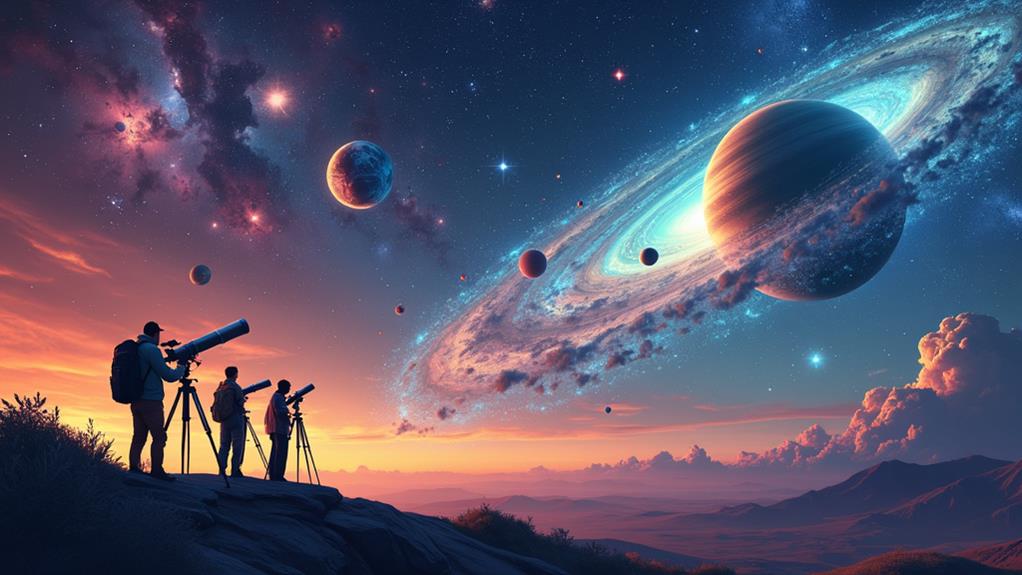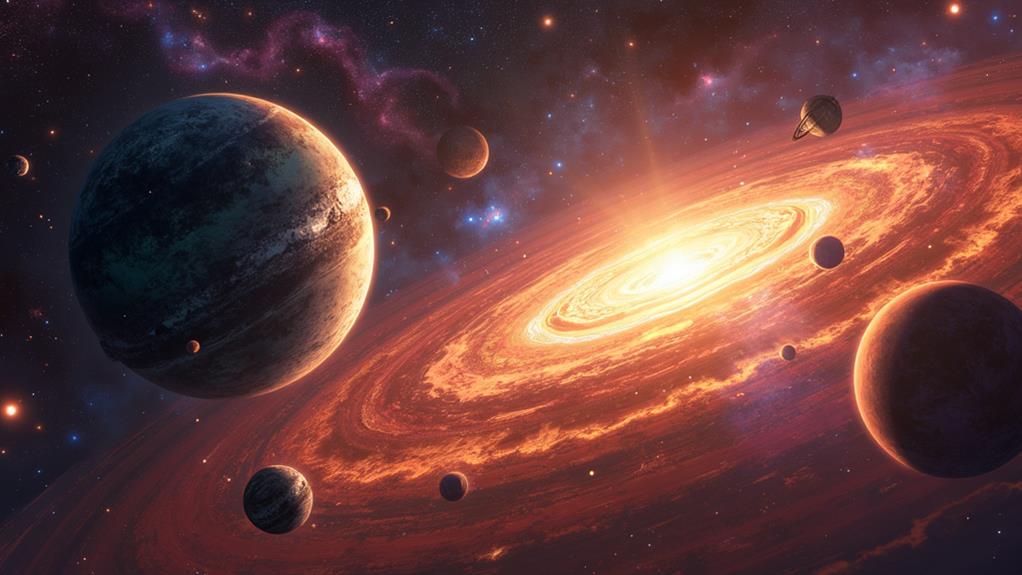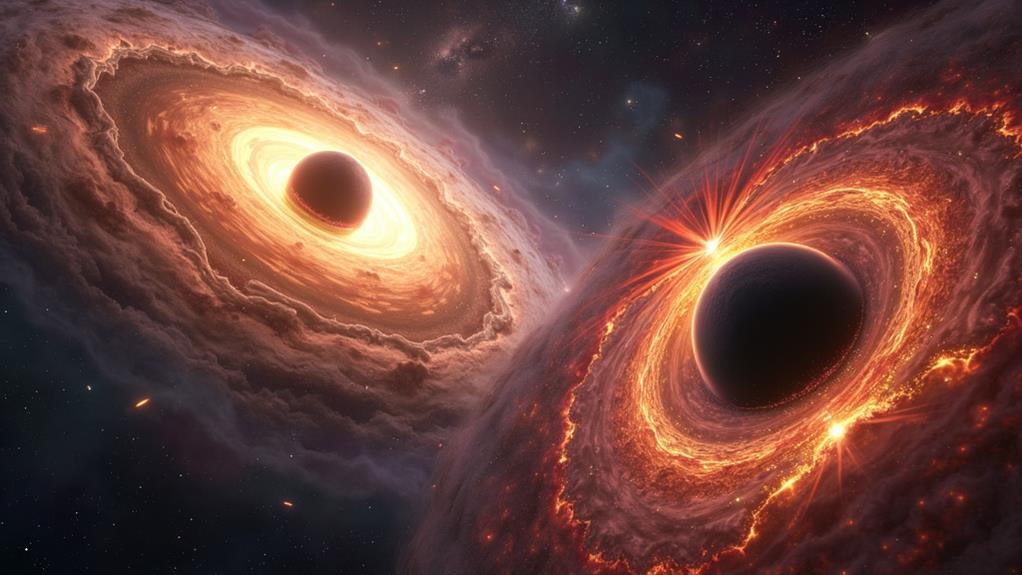Rare Celestial Phenomena in Exoplanet Systems

In exoplanet systems, you'll encounter some incredible celestial phenomena. Imagine glass rain on HD 189773b, where winds whip at 8,700 km/h, or 55 Cancri e, a super-Earth with a likely diamond-rich interior. The hottest known exoplanet, KELT-9b, sizzles at 4,300°C and zooms around its star in just 1.5 Earth days. WASP-121b hosts metallic clouds and can vaporize metals, showcasing extreme weather. These planets highlight the universe's wild range of extreme temperatures and unique compositions. Stay tuned to investigate more about these rare and enthralling celestial wonders.
Key Takeaways
- Glass Rains on HD 189773b: This exoplanet experiences glass rains due to silicate particles in its atmosphere.
- Diamond-Rich Interior of 55 Cancri e: Likely has a diamond-rich interior, making it a unique super-Earth.
- Extreme Winds on HD 189773b: Surface winds reach speeds of up to 8,700 km/h, creating extreme weather conditions.
- Vaporized Metals on WASP-121b: The atmosphere can vaporize metals, forming metallic clouds.
- Darkness of TrES-2b: This exoplanet reflects less than 1% of incoming light, making it the darkest known planet.
Unique Exoplanet Characteristics
Regarding unique exoplanet characteristics, the universe doesn't disappoint. When you investigate the cosmos, you'll encounter a variety of exotic planets that stretch the imagination. For instance, HD 189773b, a gas giant, experiences violent surface winds reaching 8,700 km/h. Imagine glass rains due to silicate particles in the atmosphere, with a scorching surface temperature of around 1,300°C.
Then there's TOI 849 b, one of the most massive rocky planets ever found. Weighing in at 40 times the mass of Earth, this rocky behemoth has a surface temperature of approximately 1,530°C but lacks an atmosphere. It's a stark contrast to typical rocky planets you're familiar with.
Consider 55 Cancri e, the initial identified super-Earth. This rocky planet likely has a diamond-rich interior owing to its high carbon composition. Its surface temperature is an extreme 2,700°C, making it one of the hottest rocky planets known.
Lastly, KELT-9b, the hottest exoplanet, boasts a surface temperature of 4,300°C and completes its orbit in less than 1.5 Earth days. These examples highlight the astonishingly diverse characteristics of exotic planets you can find in the universe.
Extreme Weather and Atmospheres
Extreme weather and atmospheres on exoplanets present some of the most mind-bending conditions you could imagine. Take WASP-121b, for example. This hot Jupiter endures surface temperatures exceeding 3,000°C, with metallic clouds and an atmosphere capable of vaporizing metals. It's one of the most extreme atmospheres you'll ever encounter.
Then there's HD 189773b, where winds scream at 8,700 km/h, carrying silicate particles that turn into glass rain. This exoplanet's surface temperature hovers around a scorching 1,300°C. Imagine a world where glass shards rain down from the sky!
KELT-9b holds the title for the hottest known exoplanet, with a blistering surface temperature of about 4,300°C. Its year lasts less than 1.5 Earth days, making it an incredibly hostile environment.
LHS 3844b offers no respite either, featuring a surface covered in lava at around 1,000°C. With no atmosphere detected, it stands as a stark example of extreme planetary conditions.
Lastly, WASP-12b is so close to its host star that it's distorted by intense stellar radiation. This proximity leads to severe atmospheric swelling and extreme weather patterns, making it one of the most unusual exoplanets ever observed.
Discovery Techniques

After investigating the mind-bending conditions on diverse exoplanets, you might wonder how scientists manage to reveal these distant worlds. The revelation techniques used to detect exoplanets are nothing short of fascinating.
First, the Transit Method has been incredibly successful. By measuring dips in starlight when a planet passes in front of its host star, scientists can infer the planet's size and even analyze its atmosphere. This method has led to the identification of thousands of exoplanets.
Next, the Radial Velocity Method observes the star's wobble due to the gravitational pull of orbiting planets. This technique relies on the Doppler effect to detect shifts in the star's light wavelengths, revealing the presence of exoplanets.
Direct Imaging is another technique, aiming to capture light from the planets themselves. Although challenging due to the stars' overwhelming brightness, it has successfully located 69 exoplanets as of November 2023.
Gravitational Microlensing exploits the bending of light around massive objects, enabling the identification of rogue exoplanets that don't orbit any star.
Lastly, Astrometry carefully measures stars' precise movements to infer orbiting planets' presence, helping build a thorough understanding of exoplanet systems. Each of these techniques offers unique insights, painting a vivid picture of our universe.
Notable Findings
In the context of notable findings in the domain of exoplanetary science, the identification of water vapor in the atmosphere of K2-18b stands out. This revelation suggests potential for habitable conditions, raising significant interest in its atmospheric composition. Among the exoplanets uncovered, K2-18b resides in the habitable zone, making it a prime candidate for further study.
Another fascinating finding is WASP-121b, an exoplanet with metallic clouds and vaporized metals, thanks to its extreme surface temperature exceeding 3,000°C. This highlights the unusual weather patterns that can exist in exoplanet systems. The detection of organic molecules in the atmospheres of certain exoplanets also indicates the possibility of biosignatures, hinting at conditions suitable for life.
Unique exoplanets like TrES-2b, the darkest known planet, reflect less than 1% of incoming light, showcasing extraordinary atmospheric characteristics. Moreover, the presence of moons around exoplanets, such as those found in the TRAPPIST-1 system, expands the scope for habitability assessments and the search for extraterrestrial life.
When considering these notable findings, it's clear that the study of exoplanet systems offers incredible insights into the potential for diverse and habitable environments beyond our solar system.
Future Research Directions

As the field of exoplanetary science advances, future research directions are poised to utilize cutting-edge space telescopes for detailed atmospheric characterization, potentially uncovering biosignatures and refining our understanding of habitability. These advancements will not only improve our grasp of exoplanet atmospheres but also open new avenues in the study of rogue planets and planet formation.
Future research will focus on:
- Advanced Space Telescopes: Upcoming missions with direct imaging capabilities will detect and analyze exoplanet atmospheres, focusing on organic molecules and water vapor.
- Computational Models: By simulating planetary system dynamics, new models will reveal insights into the formation and evolution of exoplanets, especially in multi-planet systems.
- International Collaboration: Space agencies worldwide will share data and resources, promoting a thorough study of exoplanet atmospheres and climates.
Scientists are increasingly interested in rogue planets, which wander through space without a host star. Studying these isolated worlds could provide unique insights into planetary formation and the diversity of celestial phenomena. By leveraging international cooperation and advanced technology, you'll be at the forefront of uncovering the mysteries of exoplanetary systems. These efforts will certainly bring us closer to finding potentially habitable worlds beyond our solar system.
Frequently Asked Questions
What Is the Rarest Celestial Phenomenon?
The rarest celestial phenomenon you could encounter is the detection of gravity waves. These ripples in spacetime, caused by massive cosmic events, are incredibly elusive. Furthermore, observing the cosmic microwave background offers a glimpse into the universe's infancy, but it's not a daily occurrence. Dark matter, which doesn't emit light, also remains one of the universe's biggest mysteries and is extremely difficult to detect directly.
What Is the Most Unique Exoplanet?
You might find 55 Cancri e the most unique exoplanet due to its unusual atmosphere with potential diamond composition. It endures extreme temperatures of around 2,700°C. Imagine a planet in a distant orbit with such a blistering surface! The combination of high carbon content and these extreme conditions make it stand out among other exoplanets, offering a fascinating plunge into the diversity of celestial bodies.
What Is the Darkest Exoplanet?
The darkest exoplanet is TrES-2b. You won't believe how little light it reflects—less than 1%! This dark exoplanet, located 750 light-years away in Draco, owes its extreme darkness to its atmospheric composition, filled with light-absorbing chemicals. Orbiting its star every 2.47 days, TrES-2b's high surface temperature doesn't help either. It's fascinating how these unique properties contribute to its unparalleled light absorption.
What Is the Mysterious Planet in Space?
You're wondering about the most mysterious planet in space. Search no further than KELT-9b. This exoplanet intrigues scientists with its scorching temperatures and mysterious atmospheres. Its unusual orbit around its host star leads to extreme heat, while hidden moons might exist undetected due to its brightness. KELT-9b challenges our understanding of planetary systems and offers a glimpse into the complexities of exoplanetary science.




